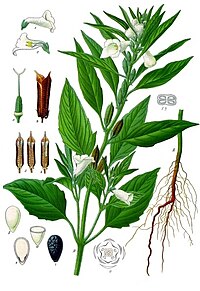
Photo from wikipedia
Growth of sesame is known to be limited by poor K nutrition as a result of imbalance in soil exchangeable cations that cause a competitive ion effect in continuous monocropping… Click to show full abstract
Growth of sesame is known to be limited by poor K nutrition as a result of imbalance in soil exchangeable cations that cause a competitive ion effect in continuous monocropping from upland fields converted paddy. We hypothesized that balancing soil exchangeable cations will improve the K nutrition and growth of sesame plants. Therefore, the specific objectives of this study were to determine the effect of balancing soil exchangeable cations Ca, Mg, and K of continuously monocropped soils on the growth and cation uptake of sesame seedlings and also identify a suitable source of nutrients for improving K nutrition. A pot experiment was conducted under greenhouse condition in a 3 × 3 factorial design consisting of three levels of balancing treatments i.e. inorganic fertilizer for Ca, Mg, and K, rice husk biochar to increase K content, and the three durations of continuous monocropping soils of one year, two years, and four years from upland fields converted paddy. Balancing soil exchangeable cations was aimed at achieving optimal base saturations (CaO, 75%; MgO, 25%; and K2O, 10%). Results showed that balancing exchangeable cations did not significantly affect growth and cation uptake in the one and two-year soils but significant effect was observed in the four-year soil. Overall, plant height and dry weight increased for the balancing treatments of inorganic fertilizer K and rice husk biochar. Balancing exchangeable cations with biochar was more beneficial than with inorganic fertilizers. The four-year soil’s growth increase was attributed to an increase in K concentration and uptake due to the decrease in the soil Ca/K and Mg/K ratios to that of acceptable levels, which eliminated competitive ion effect as the soil K saturation increased above 5.0%, enhancing sesame growth. Therefore, a balanced soil exchangeable Ca, Mg, and K that eliminates a competitive ion effect will improve sesame growth and K nutrition although future research should focus on ensuring balanced cation rations under field conditions in continuous monocropping.
Journal Title: Agronomy
Year Published: 2019
Link to full text (if available)
Share on Social Media: Sign Up to like & get
recommendations!